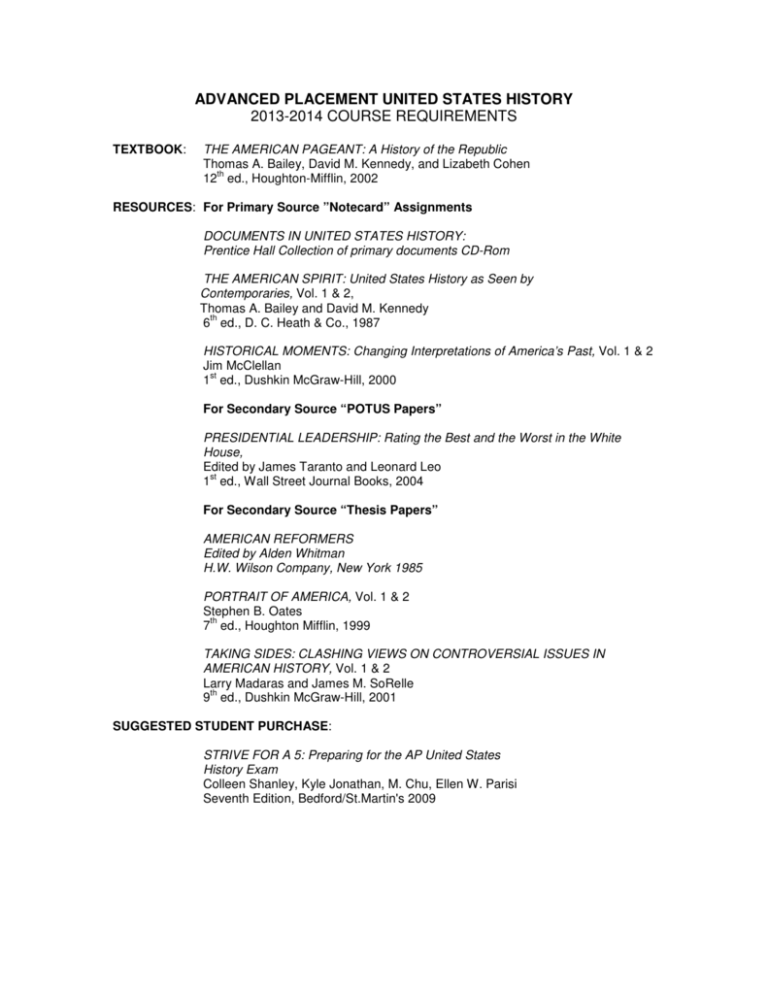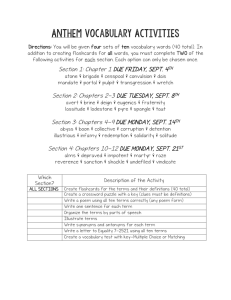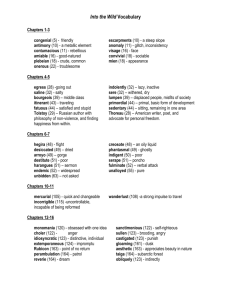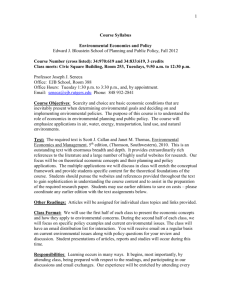advanced placement united states history 2013
advertisement

ADVANCED PLACEMENT UNITED STATES HISTORY 2013-2014 COURSE REQUIREMENTS TEXTBOOK: THE AMERICAN PAGEANT: A History of the Republic Thomas A. Bailey, David M. Kennedy, and Lizabeth Cohen th 12 ed., Houghton-Mifflin, 2002 RESOURCES: For Primary Source ”Notecard” Assignments DOCUMENTS IN UNITED STATES HISTORY: Prentice Hall Collection of primary documents CD-Rom THE AMERICAN SPIRIT: United States History as Seen by Contemporaries, Vol. 1 & 2, Thomas A. Bailey and David M. Kennedy th 6 ed., D. C. Heath & Co., 1987 HISTORICAL MOMENTS: Changing Interpretations of America’s Past, Vol. 1 & 2 Jim McClellan st 1 ed., Dushkin McGraw-Hill, 2000 For Secondary Source “POTUS Papers” PRESIDENTIAL LEADERSHIP: Rating the Best and the Worst in the White House, Edited by James Taranto and Leonard Leo st 1 ed., Wall Street Journal Books, 2004 For Secondary Source “Thesis Papers” AMERICAN REFORMERS Edited by Alden Whitman H.W. Wilson Company, New York 1985 PORTRAIT OF AMERICA, Vol. 1 & 2 Stephen B. Oates th 7 ed., Houghton Mifflin, 1999 TAKING SIDES: CLASHING VIEWS ON CONTROVERSIAL ISSUES IN AMERICAN HISTORY, Vol. 1 & 2 Larry Madaras and James M. SoRelle th 9 ed., Dushkin McGraw-Hill, 2001 SUGGESTED STUDENT PURCHASE: STRIVE FOR A 5: Preparing for the AP United States History Exam Colleen Shanley, Kyle Jonathan, M. Chu, Ellen W. Parisi Seventh Edition, Bedford/St.Martin's 2009 COURSE DESCRIPTION The Advanced Placement United States History course is a two-semester class that offers a th survey of American History since the 15 century at college-level pace. Extensive reading, writing, and study skills useful in college will be emphasized. The class concludes with a college level exam, prepared by the College Board, which, if passed, may result in college credit. The exam for 2014 will be given on Wednesday, May 14, at 8:00 am. There is a fee for this exam. The course is designed to provide a comprehensive overview of U. S. History and to provide students with analytical skills and factual knowledge to deal critically with the problems and materials in United States history. Students should learn to assess historical materials – their relevance to a given interpretive problem, their reliability and their importance – and to weigh the evidence and interpretations presented in historical scholarship. 1. 2. 3. 4. 5. 6. 7. 8. 9. 10. 11. 12. 13. 14. 15. Furthermore, students will develop: their ability to understand and respect other points of view, both personal and cultural. Included within this should be the ability to understand peoples of different races and cultures and show respect for human diversity and for students’ varied talents and perspectives. Also, students should explore the interaction among peoples of different races and cultures and how such interaction has shaped United States and world history. an informed historical perspective, including an understanding of how one's own society developed, and an awareness of how other societies developed. their understanding the major ways that science and technology have affected humans and their world. their understanding of the power and limitations of science and technology in a changing world; awareness of how societies, institutions, and individuals are responsible to see that technology is used ethically and appropriately. their understanding of the influence of geographic characteristics, including climate, physical features and natural resources, on North America's major societies and cultures. their understanding of the context of current events from a historical perspective with the ability to connect modern trends to past events. their understanding of current events from an international perspective. their ability to integrate into the curriculum a wide variety of materials as well as human and technological resources, including primary documents, texts, maps, graphs, charts, and other resources. their understanding of the concept of change over time with the ability to relate past to present. their understanding of the major events and movements in American history, the turning points of historical development, and their relationship to the present. their understanding of cultural and individual diversity, and humankind’s shared environment, heritage, and responsibility. their ability to explore critical eras in the historical development of the world in the following spheres of human activity: social, political, scientific, military, technological, economic, and cultural (philosophical, religious, and aesthetic). the ability to apply the techniques of historical interpretation including cause and effect, major trends, change over time, etc. their ability to use knowledge of the civilization of the United States to develop in themselves the skills of thinking, reasoning, problem solving, and decision making. an informed historical perspective, including an understanding of how one’s own society developed and an awareness of how other societies developed. 1. 2. 3. 4. Additional Student Learning Outcomes: In the process of fulfilling assignments in the course, students will have opportunity to demonstrate and improve the quality of their critical thinking, reading, and writing abilities. In the process of fulfilling assignments in the course, the student will be able to identify important individuals and events that have contributed to the development of American history. In the process of fulfilling assignments in the course, students will learn to critically and analytically read historical works and primary sources. In the process of fulfilling assignments in the course, will begin to understand the connection between the United States and Western Civilization in addition to the global community. HOMEWORK Advanced Placement courses are demanding and require daily homework. Students planning to earn a score of 4 or 5 will spend a MINIMUM of SEVEN hours per week studying. Begin planning and preparing now to take the A.P. exam in May. Homework is mainly reading and NOT daily written work or take-home worksheets. There will be a quiz each Monday on the previous week’s chapter reading. The bonus to the student is that they can plan their own study time to more easily match their schedule. The pitfall is that the student can easily slack off and, after 7-10 days, fall rapidly behind. All assignments are given in advance to allow students to organize their time. The College Board’s AP US History curriculum demands a tight schedule. Every effort will be made to strictly adhere to the syllabus. GRADING Grading for AP will be on a point system. Points are totaled to determine the grade for each grading period. The scale is listed below. It is advised that students KEEP EXCELLENT NOTEBOOKS. Inadequate and poor planning on the student’s part does not constitute an emergency on the teacher’s part. In short, if you see you are behind and NEED an “A”, plan better and study harder. The teacher will use Quiz scores, essay answers, notebook status, and participation as a reason to "Invite" you to attend study sessions during PAWS, or after school. If you are a no show parents will be informed. GRADING SCALE: 98-92% = A, 90-91.9% = A-, 88-89.9% = B+, 82-87.9% = B, 80-81.9% = B-, 78-79.9% = C+, 72-77.9% = C, 70-71.9% = C-, 68-69.9% = D+, 62-60.0% = D, 0-59.9% = F. GRADE COMPONENTS: Tests / Quizzes 30% Weekly Reading Quizes, Free Response Essays, Unit Multiple Choice Tests, DBQ Essays Final Exams 25% Semester 1 Final Exam 2 day M/C F/R DBQ, Semester 2 Final Exam 2 day M/C F/R DBQ Participation 15% Class Participation: Daily Interactive Questioning every lecture/discussion period Document Analysis 15% Document Analysis notes (readings and analysis of selected primary source readings) Thesis paper (readings and analysis of selected secondary source readings) Notebook 15% POTUS Papers (readings and analysis of selected secondary source readings about Presidents) Book Notes from text Class Notes from discussions, lectures and handouts Test Corrections to regain 1/2 of the points missed on an exam Students will be given an opportunity to perform test corrections for 1/2 credit if they have kept up with the work listed above. Quizzes, Participation, Document Analysis, and Notebooks need to be current if the student expects to take advantage of this opportunity. By appointment only. THEMES OF AP US HISTORY COVERED IN THIS COURSE 1. American Culture – diverse individual and collective expressions through literature, art, philosophy, music, theater, and film throughout U.S. history. Popular culture and the dimensions of cultural conflict within American society. 2. American Diversity – diversity of U.S. people and relationships among different groups. The role of race, class, ethnicity, and gender in the history of the U.S. 3. American Identity –views of the American national character & ideas about U.S. exceptionalism. Recognizing regional differences within the context of what it means to be an American. 4. Demographic Changes – political, social, economic implications – changes in birth, marriage, and death rates; life expectancy and family patterns; population size and density. The economic, social, and political effects of immigration, internal migration, and migration networks. 5. Economic Transformation – changes in trade, commerce, and technology across time. The effects of capitalist development, labor and unions, and consumerism. 6. Environmental Issues – ideas about the consumption and conservation of natural resources. The impact of population growth, industrialization, pollution, and urban and suburban expansion. th 7. Globalization – engagement with the world from the 15 century to present: colonialism, mercantilism, global hegemony, development of markets, imperialism, cultural exchange. 8. Politics & Citizenship – colonial and revolutionary legacies, U.S. political traditions, growth of democracy, & development of the modern state. Defining citizenship; struggles for civil rights. 9. Religion in the U.S. – the variety of religious beliefs and practices in America from st prehistory to the 21 century; influence of religion on politics, economics, and society. 10. Slavery and its impact and legacy – systems of slave labor and other forms of unfree labor (e.g., indentured servants, contract labor) in Native American societies, the Atlantic World, and the American South and West. The economics of slavery and its racial dimensions. Patterns of resistance and the long-term economic, political and social effects of slavery. 11. Social & Political Movements and Reforms – includes anti-slavery, education, labor, temperance, women’s rights, civil rights, gay rights, public health, and government. st 12. War & Diplomacy – armed conflict from the pre-colonial period to the 21 century; impact of war on American foreign policy and on politics, economy, and society. UNIT CONTENT AND THEMATIC EMPHASIS The list of topics for each unit is not exhaustive. Though all 12 of the AP US History Themes are incorporated into most units, not all lend themselves to each one. The thematic emphases listed below each unit are the ones most relevant to that unit. The themes are indicated by the numbers listed in the elaboration of themes above. UNIT 1- BEGINNINGS THROUGH REVOLUTION Before Columbus, Spanish, French and British Colonization, Push-Pull factors, Colonial Sections, Cultural Differences, Mercantilism, Awakenings, Patterns of Society, Post-1763 British Policy. Thematic Emphasis: #7, 8, 9 10 UNIT 2-REVOLUTIONARIES TO RULERS Loosening Ties, The Colonies United, The War for Independence, War and Society, Creation of State Governments, The Articles of Confederation, The Constitution, Federalists and Republicans, Hamilton vs. Jefferson. Thematic Emphasis: #3, 5, 8 UNIT 3-FROM JEFFERSON TO JACKSON The Revolution of 1800, The War of 1812, The Marshall Court, Cultural Nationalism, Expansion, Era of Good Feelings, Sectionalism, Mass Politics, Indian Removal, The Bank War, Jacksonian Democracy, Manifest Destiny. Thematic Emphasis: #2, 4, 5, 12 UNIT 4-AN AMERICAN CULTURE AND SECTIONALISM The Politics and Culture of Slavery, The Changing Population, Transportation, Commerce and Industry, Sectional Differences, Remaking Society, Abolition, Temperance, Women’s Rights. Thematic Emphasis: #1. 9. 10, 11 UNIT 5-THE CIVIL WAR The Crises of the 1850s, the Secession Crisis, Mobilization, Strategy and Diplomacy, Compromises, Dred Scott, Terrorism and Conflict. Thematic Emphasis: #3. 8, 10, 11, 12 UNIT 6-RECONSTRUCTION AND RELOCATION Types of Reconstruction Plans, Radical Reconstruction, Impeachment, Governmental Corruption, Abandoning Reconstruction, The New South, Societies of the West, Dispersal of the Tribes, Urbanization, Agricultural Revolution, Leisure, The Rise of Unionism, Agrarian Revolt, DuBois vs. Washington, Consolidation. Thematic Emphasis: #1, 2, 3, 4, 5, 6, 10 UNIT 7-IMPERIALISM AND PROGRESSIVISM Progressivism, Women and Reform, TR and the Modern Presidency, the Big Stick, Muckrakers, Immigration, Imperialism in Cuba and the Pacific, Diplomacy, America and the World. Thematic Emphasis: #3, 5, 6, 11, 12 UNIT 8-WORLD WAR I, BOOM AND BUST The Road to War, War and Society, New World Order, New Cultures and Conflict, Wilsonian Idealism, KKK, Immigration Issues, Anarchists, Jazz Age, Boom Times, Depression. New Deal, Court Reactions, Extremist Alternatives, Society and Hard Times, Decline of the New Deal. Thematic Emphasis: #5, 7, 9, 11, 12 UNIT 9-WORLD WAR II AND POST-WAR Isolationism and Internationalism, Neutrality, Intervention, War on Two Fronts, Alliances, Origins of the Cold war, Korea, Containment, Science and Technology, Rise of the Civil Rights Movement, Flexible Response, Red Scare. Thematic Emphasis: #5, 7, 9, 11, 12 UNIT 10-MY GENERATION AND YOURS Expanding the Liberal State, Vietnam, 1968, The Youth Culture, The New Feminism, Mobilization of Minorities, Environmentalism, Turbulent Society, Watergate, the Reagan Revolution, End of the Cold War, Globalization, the New Partisanship, the War on Terror. Thematic Emphasis: #1, 2, 3, 4, 6, 7, 11, 12 AP UNITED STATES HISTORY 2013-2014 COURSE TEXTUAL READING OUTLINE WEEK DATE READINGS 1 Sept. 4-6 UNIT 1- BEGINNINGS THROUGH REVOLUTION Chapter 1 New World Beginnings, 33,000 B.C.-A.D. 1769 2 Sept. 9-13 Chapters 2, 3 The Planting of English America, 1500-1733 Settling the Northern Colonies, 1619-1700 3 Sept. 16-20 Chapter 4 American Life in the Seventeenth Century, 1607-1692 4 Sept. 23-27 Chapters 5, 6 Colonial Society on the Eve of the Revolution, 1700-1775 The Duel for North America 5 Sept.30-Oct.4 UNIT 2-REVOLUTIONARIES TO RULERS Chapter 7 The Road to Revolution, 1763-1775 6 Oct. 7-11 Chapters 8, 9 America Secedes from Empire, 1775-1783 The Confederation and the Constitution, 1776-1790 7 Oct. 14-18 Chapter 10 Launching the New Ship of State, 1789-1800 8 Oct. 21-25 UNIT 3-FROM JEFFERSON TO JACKSON Chapter 11 The Triumph and Travails of Jeffersonian Democracy, 1800-1809 9 Oct. 28-Nov.1 Chapter 12 The Second War for Independence and the Upsurge of Nationalism, 1809-1815 10 Nov.4-8 Chapter 13 The Rise of a Mass Democracy, 1824-1840 11 Nov. 11-15 Chapter 14 Forging the National Economy, 1790-1860 12 Nov. 18-22 UNIT 4-AN AMERICAN CULTURE AND SECTIONALISM Chapter 15 The Ferment of Culture and Reform, 1790-1860 13 Nov. 25-27 Chapter 16 The South and the Slavery Controversy, 1793-1860 THANKSGIVING RECESS (Nov. 28-Dec. 1) 14 Dec. 2-6 Chapter 17 Manifest Destiny and Its Legacy, 1841-1848 15 Dec. 9-13 Chapter 18 Renewing the Sectional Struggle, 1848-1854 16 Dec. 16-20 UNIT 5-THE CIVIL WAR Chapter 19 Drifting Toward Disunion, 1854-1861 17-18 Vacation Chapters 20, 21 Girding for War: The North and the South, 1861-1865 The Furnace of Civil War, 1861-1865 WINTER RECESS (Dec. 21-Jan. 5) 19 Jan. 6-10 UNIT 6-RECONSTRUCTION AND RELOCATION Chapter 22 The Ordeal of Reconstruction, 1865-1877 20 Jan. 13-17 Chapter 23 Political Paralysis in the Gilded Age, 1869-1896 21 Jan.20-24 Chapter 24 Industry Comes of Age, 1865-1900 Martin Luther King, Jr. Observance (Jan. 20) MIDTERM EXAMS-JAN. 22-24 22 Jan 27-31 Chapters 25, 26 America Moves to the City, 1865-1900 The Great West and the Agricultural Revolution, 1865-1900 23 Feb. 3-7 UNIT 7-IMPERIALISM AND PROGRESSIVISM Chapter 27 The Path of Empire, 1890-1899 24 Feb. 10-14 Chapters 28 America on the World Stage, 1899-1909 Progressivism and the Republican Roosevelt, 1901-1912 25 Feb. 17-21 Chapter 29, 30 Wilsonian Progressivism at Home and Abroad, 1912-1916 26 Feb. 24-28 UNIT 8-WORLD WAR I, BOOM AND BUST Chapters 31, 32 The War to End War, 1917-1918 American Life in the Roaring Twenties, 1919-1929 27 Mar. 3-7 28 Mar. 10-14 Chapter 33 The Politics of Boom and Bust, 1920-1932 Chapters 34, 35 The Great Depression and the New Deal, 1933-1939 Franklin D. Roosevelt and the Shadow of War, 1933-1941 29 Mar. 17-21 UNIT 9-WORLD WAR II AND POST-WAR Chapter 36 America in World War II, 1941-1945 30 Mar. 24-28 Chapters 37-38 The Cold War Begins, 1945-1952 The Eisenhower Era, 1952-1960 SPRING RECESS (March 29-April 6) 31 Apr. 7-11 Chapters 37-38 The Cold War Begins, 1945-1952 The Eisenhower Era, 1952-1960 32 Apr. 14-18 UNIT 10-MY GENERATION AND YOURS Chapters 39,40 The Stormy Sixties, 1960-1968 The Stalemated Seventies, 1968-1980 33 Apr. 21-25 Chapters 39,40 The Stormy Sixties, 1960-1968 The Stalemated Seventies, 1968-1980 34 Apr. 28-May 2 Chapter 41 The Resurgence of Conservatism, 1980-2000 35 May 5-9 Chapter 42 The American People Face a New Century AP UNITED STATES HISTORY 2013-2014 Course Syllabus (All days and dates are subject to change due to weather, holidays, acts of God, war, plague, end of the world or, worst of all, pep assemblies) (t)=Thesis Paper (n)= Note Card: Eval Orig Docs (p) POTUS Paper WEEK DATE ASSIGNMENT 1 Sept. 4-6 Introduction to class Letter of Columbus to Luis de Santangel (n) 2 Sept. 9-13 Essay Writing Strategies Class Notes Study Skills and Reading Techniques Colonial Class Status (n) Starving Time (n) 3 Sept. 16-20 Documentary Analysis DBQ Formatting The Puritans and Sex - Morgan (t) 4 Sept. 23-27 Sinners in the Hands of an Angry God (n) 5 Sept.30-Oct.4 Historiography-The Constitution The Most Successful Revolution - Kristol (t) Address to the Inhabitants of Massachusetts Bay (n) Unit 1 Test (Chapters 1-6) 6 Oct. 7-11 DBQ #1 Alexander Hamilton Criticizes the Articles of Confederation (n) Patrick Henry Speaks Before the Virginia Ratifying Convention (n) 7 Oct. 14-18 Historical Interpretation and Varying Viewpoints Washington and Adams (p) Alexander Hamilton-The Founding Wizard – Gordon (t) Hamilton and Jefferson on Democracy (n) 8 Oct. 21-25 Unit 2 Test (Chapters 7-10) Jefferson (p) Marbury v. Madison – Garraty (t) 9 Oct 28-Nov.1 Document Analysis Mid-Semester Exam (Chapters 1-11) Madison and Monroe (p) The Monroe Doctrine (n) 10 Nov. 4-8 JQ Adams, Jackson and Van Buren (p) Historiography-What Was Jacksonian Democracy? Andrew Jackson and Cherokee Removal – Bowles (t) Daniel Webster Pleads for Union (n) Senator Robert Hayne Advocates Nullification (n) 11 Nov. 11-15 Historiography-Reform: Who? What? How? Why? Harrison and Tyler (p) 12 Nov. 18-22 Unit 3 Test (Chapters 11-14) 13 Nov. 25-27 Declaration of Sentiments (n) DBQ #2 The Blessings of Slavery (n) William Lloyd Garrison from the Liberator (n) Black Slaveowners – Burnham (t) Thanksgiving Recess (Nov. 28- Dec. 1) 14 Dec. 2-6 Polk and Taylor (p) 15 Dec. 9-13 Fillmore and Pierce (p) 16 Dec. 16-20 Unit 4 Test (Ch. 15-18) Buchanan (p) Historiography: The Civil War: Repressible or Irrepressible? John Brown-Father of American Terrorism – Chowder (t) 17-18 Vacation Lincoln (p) Historiography-How Radical was Reconstruction? WINTER RECESS (Dec. 21-Jan. 5) 19 Jan. 6-10 Johnson (p) A Whig Account of the New York Draft Riots (n) nd Lincoln’s 2 Inaugural Address (n) Reconstruction – McPherson (t) Term Paper Assigned (Due May 29) 20 Jan. 13-17 Unit 5 Test (Ch. 19-21) DBQ #3 Grant and Hayes (p) 21 Jan.20-24 Martin Luther King Observance (Jan. 20) Mid-Term Exams (Jan. 22-24) 22 Jan. 27-31 Historiography-Industrialization: Boon or Blight? Garfield and Arthur (p) The Robber Baron’s Bum Rap-Klein (t) Andrew Carnegie from the Gospel of Wealth (n) Term Paper topics selected (paper is due 6/1/08) 23 Feb. 3-7 Historiography-The Populists: Radicals or Reactionaries? Cleveland (1 and 2) and Harrison (p) Our Country (n) Atlanta Exposition Address (n) Of Mr. Booker T. Washington and Others (n) 24 Feb. 10-14 Unit 6 Test (Chapters 22-26) McKinley (p) Plessy v. Ferguson (n) A Century of Dishonor (n) Significance of the Frontier in American History (n) 25 Feb. 17-21 DBQ #4 TR (p) Historiography-Why Did American Become a World Power? The New Nationalism (n) Theodore Roosevelt-President – Morris (t) 26 Feb. 24-28 Taft and Wilson (p) Upton Sinclair on the Chicago Stockyards – Sinclair (t) Zimmermann Telegram (n) 27 Mar. 3-7 Harding and Coolidge (p) The Most Scandalous President – Anthony (t) 28 Mar. 10-14 Unit 7 Test (Chapters 27-31) Historiography- student perspective Hoover (p) 29 Mar. 17-21 FDR (p) Historiography-How Radical Was the New Deal? Mid-Semester Exam (Chapters 24-33) The Big Picture of the Great Depression – Garraty (t) st FDR’s 1 Inaugural Address (n) 30 Mar. 24-28 Unit 8 Test (Chapters 32-35) Historiography-World War II: Triumph or Tragedy? The Internment of the Japanese – Rehnquist (t) SPRING RECESS (March 29- April 6) 31 Apr.7-11 Historiography-Who Was to Blame for the Cold War? Truman and Eisenhower (p) The Truman Doctrine (n) The Marshall Plan (n) Joseph R. McCarthy in Wheeling West Virginia (n) 32 Apr. 14-18 Kennedy, Johnson and Nixon (p) Historiography-The Sixties: Constructive or Destructive? Brown v. Board of Education of Topeka (n) Port Huron Statement (n) JFK Inaugural Address (n) Unit 9 Test (Chapters 36-38) PRACTICE AP EXAM SATURDAY 4/19/2014 33 Apr. 21-25 Ford and Carter (p) Impeachment Resolution 1974 (n) Tonkin Gulf Incident (n) The Malaise Speech (n) The Man Who Broke the Evil Empire – Schwiezer (t) 34 Apr. 28-May. 2 Historiography-Where Did Modern Conservatism Come From? Reagan and Bush 41 (p) E Pluribus Unum? – Schlesinger (t) 1982 Speech to the House of Commons (n) Unit 10 Test (Chapters 39-41) Apr. 28-May 13 REVIEW FOR APUSH EXAM 35 May. 5-9 Begin Review Clinton and Bush 43 (p) 36 May. 12-16 Pre-APUSH Exam Review for AP Exam (in class and in study groups) May 14th – 8:00a.m. APUSH Exam 37 May 19-23 “Rate the Losers” Assignment: Students will rate the best, and worst of the individuals who lost presidential elections. 38 May 26-30 “Fire” and “Losers” assignments due and presented to the class 39 Jun. 2-6 Term Paper due Relax and Review for the Final Exam 40 Jun. 9-13 Final Exams 41 Jun. 16 Check out Cleared... 20min period







